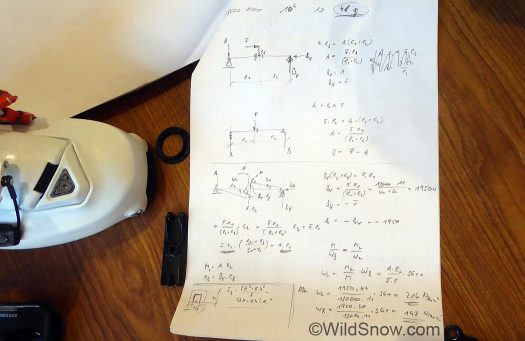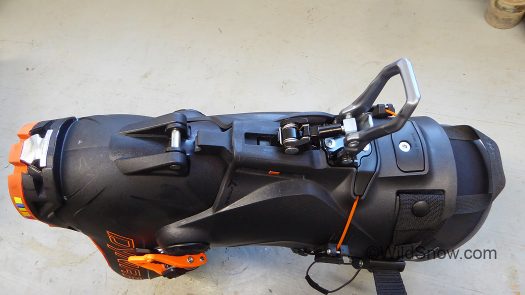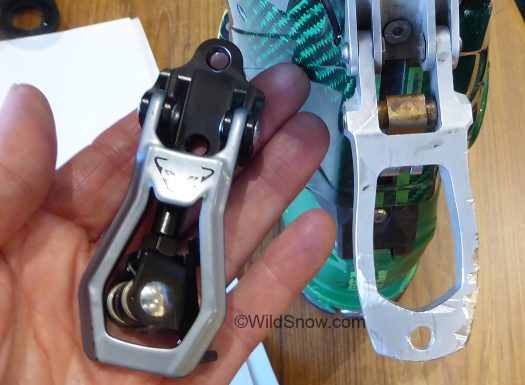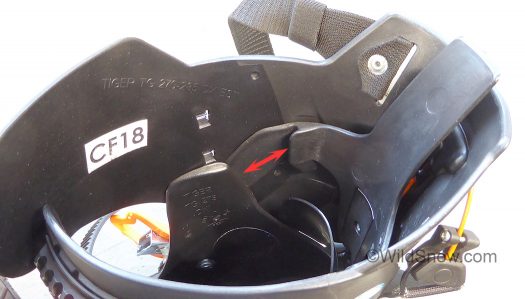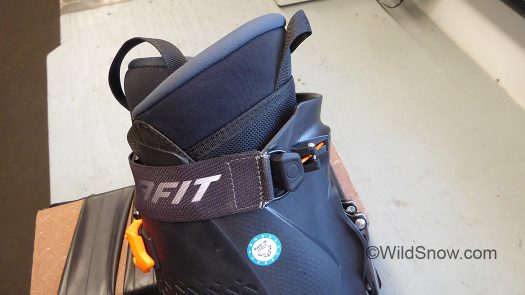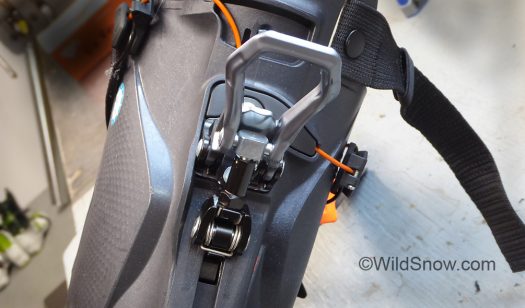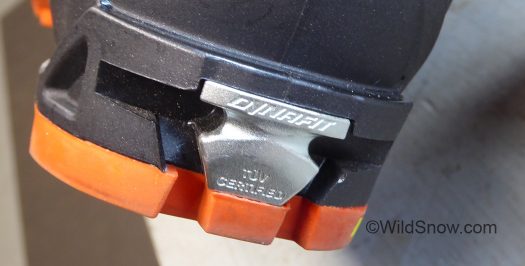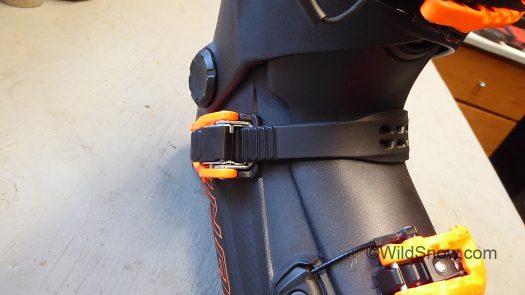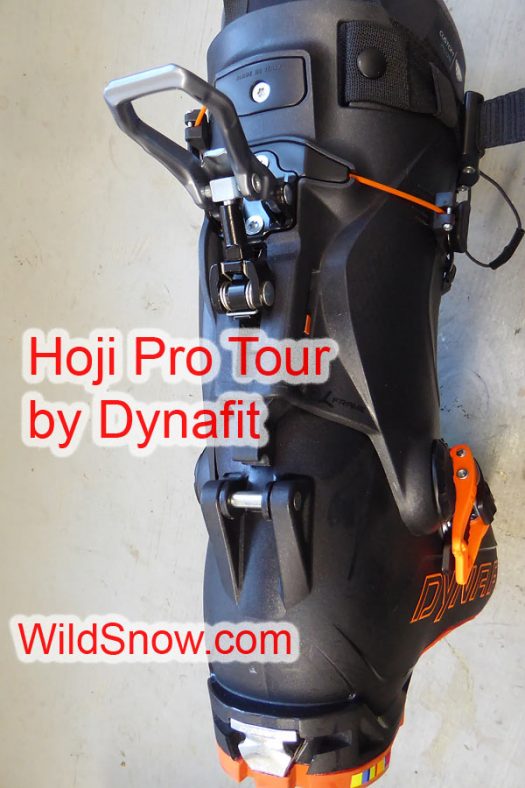(This post sponsored by our publishing partner Cripple Creek Backcountry.)
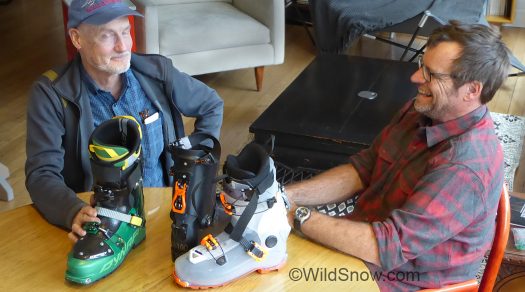
Lou (left) and boot co-developer Fritz Barthel recently met at WildSnow world HQ for a serious boot discussion. The concept of always keeping your pants down was heavily parsed.
Flip a single easy lever to transition your ski boots between uphill and downhill? I never considered that a deal breaker, but after skiing a prototype of the Dynafit Hoji Pro Tour last winter, I’m reconsidering.
Skimo racers have for decades sought the ideal of “leaving pants down,” as fiddling with clothing and boot adjustments during transitions will lose a race. In ski touring, “pants down always” has not been as big a deal (at least while skiing). But take my word, once you try a system that eliminates silly hacking with your pant cuffs, buckles and power straps, you won’t want anything else. That is, if it works — and keeps working.
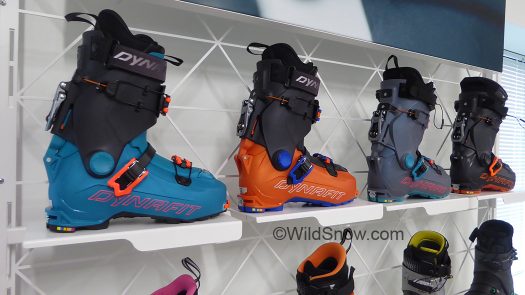
Hoji PX amd Pro Tour, full line due to retail in fall of 2018. Left to right: 1) HOJI PX Women – 1400 grams, 22.5 – 27.5 – Pebax 2) HOJI PX – 1530 grams, 25 – 30.5 – Pebax 3) HOJI PRO Tour Women – 1320 grams – 22.5 -27.7 – Grilamid 4) HOJI PRO Tour – 1450 grams – 25 – 30.5 – Grilamid
Enter Dynafit’s new Hoji PX and Pro Tour boot models. Four years in development, due to retail 2018-2019, design philosophy here is a boot that not only allows you to keep your pants down, but skis powerfully — and tours. Sure, all of that is grail stuff that’s been tried by various brands, sometimes with success, but how many times combined in the same boot? Barring unforeseen manufacturing challenges and that sort of thing, I think Dynafit might have it nailed. We’ll get more certain on that this winter, when a limited run of the boots will be seeded out for testing and feedback. Let’s do a first-look.
(Note, the Hoji boot is indeed a ski touring boot that touches the freeride realm. I’m told by insiders that a stiffer version might be in the works, but that Dynafit has somewhat of an identity crisis when it comes to how much they want to embrace the realm of the beef boot. This especially so when numerous other companies are pumping out big boots. Fact remains that building a shoe that tours well and skis decently enough is still the sweet spot in the ski touring business — despite a few recent stutters, Dynafit continues to possess major brand equity in that arena.)
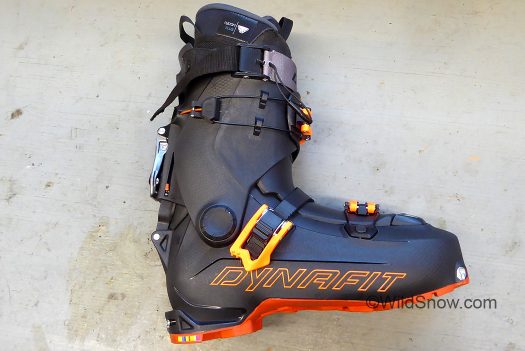
Hoji Pro Tour top model, shark nose (official name: Speed Nose) is a bit of disapointment as I’d rather see a reduced profile toe that remained universally crampon compatible. But I can live with it. Especially considering that Dynafit also has come up with the neatest crampon I’ve ever seen. Note the shark doesn’t swim as weird as he looks, nor does he bite, and he might tour slightly more efficiently due to the the toe fittings being mounted a few millimeters rear of ‘standard.’ (The closer your boot toe fittings are to your natural walking foot flex, the better they feel).
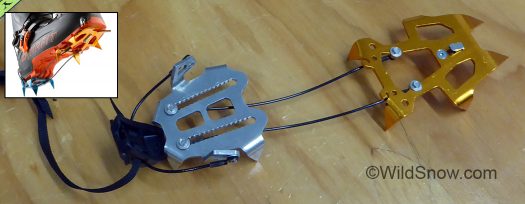
Cramp-In crampon requires a small metal fitting to be installed in the boot sole. Said to be the lightest spike on the market, catalog weight 260 grams.
There is spirit in this boot. Just a few years ago, Eric “Hoji” Hjorleifson met tech binding inventor Fritz Barthel at a Dynafit press event. Hoji was up to his usual tricks, not only on-snow shenanigans, but modding and designing ski boots. Fritz invited Hoji to visit his workshop in Austria. The two hit it off as friends, as well as having a mutual interest in making better ski footwear. Forthwith, the two embarked on a project to create the shoe they always wanted.
Fritz and Hoji have somewhat opposite approaches to design. Both sides enhancing the whole. Synergy.
“Just as with the tech binding development,” says Fritz, “I had laziness driving me — I simply wanted a boot that did not require lifting up the pant cuff, and with a ski lock lever that could be kicked down without bending over, that would lock everything into downhill mode.” Fritz goes on to explain that “Hoji comes from the opposite side, he wants a boot that skis downhill well, and tours, though he worked hard on the ‘Hoji Lock’ system as well — if for no other reason than to make apres ski beers more comfortable.”
Another interesting aspect of the Hoji Pro Tour development is the introduction of quite a bit more testing and mathematics into the development process than is often the case. While testing methods and engineering concepts have always been available and used to various degrees, the most common way of developing ski boots remains more art than science. That’s been somewhat fine up till now, or has it? The landscape of ski touring boot development is littered with failed products — expensive shibboleths that broke, did not ski well, or both (not to mention the recalls…). From the start of the project, Fritz assisted Hoji with extensive testing, engineering theory and materials science. I’ve been around the process in person, during visits to Austria, and can testify that this has been a major deal — to the extent that Fritz built his own boot flex testing machine and invoked math chops that caused Grilamid and Pebax to quiver in supplication.
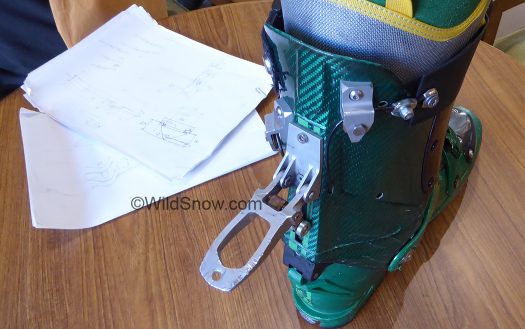
The first thing we’ll cover here is the Hoji Lock. This is the prototype hand built boot I skied in last winter. Hoji Lock works with a cable system that’s carefully tuned to open the boot for touring, lock the cuff without play for the down, all while being engineered for durability. Fritz told me an interesting part of development was when he measured the friction of cable on the small pulley wheels as pictured, and found that not using pulleys but instead running the cables over plastic ramps actually made less friction.
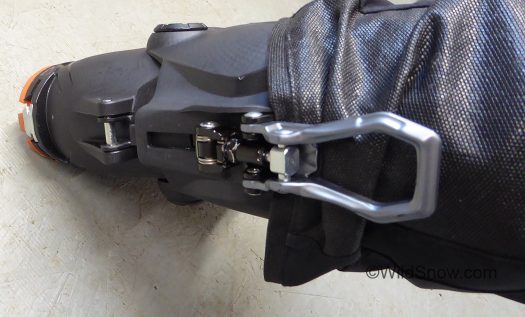
Fully open, pant cuff can be left in this type of position or pulled over the lock when you’re done changing modes. Anyone doing “hot laps” will especially appreciate a boot transition system that takes mere seconds — but in my view this system will make anyone happy. No fiddling with power strap, leave your gloves on. Pants down always.
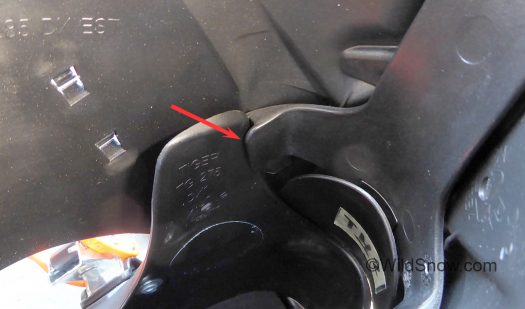
What’s exciting about Hoji Lock is the cuff flex-stop is huge, it rises up and down when you operate the lock lever. According to engineer Fritz, not only are cuff stops incredibly important for excellent downhill performance, but they prevent damage to the boot from over-flexing. Such damage isn’t always obvious, sometimes manifesting in softer performance as the boot plastic breaks down.
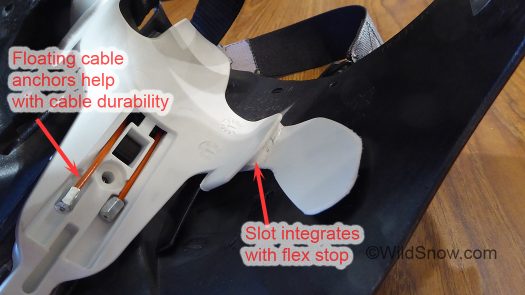
Demonstration boot’s white plastic does good job of showing the cuff stop slots. Videos below illustrate as well.

Side view of lean lock. A small colored indicator moves up and down to help you know what’s going on. Seems a bit redundant. Most importantly, note how the lean lock does not engage in both forward and rearward directions, it only resists rearward movement. Forward movement of the cuff is resisted by the cuff stops (in images above) and the general configuration of the scaffo and cuff parts. Overall design philosophy with this type of boot is you’re eliminating the shell tongue from contributing to downhill stiffness, and can thus configure the tongue so it allows excellent walking performance.

Lock closed, note the cable. which operates both the cuff buckle and the power strap. More than three years of R&D .

Cable runs over guide grooves in the plastic boot parts. This is said to create much less friction and be more reliable in terms of breakage, as opposed to metal pulleys or cable routing that’s subjected to twisting and wear due to being run through moving boot parts.
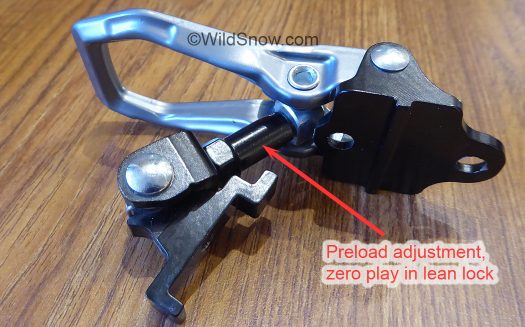
Example of purpose, a small threaded rod and nut system on the latch is used to adjust preload. That means you will NEVER be cursing about play in your cuff latch. Instead, when you kick down the lever, you will enjoy a ‘loaded’ tension fit between the latch and interior cuff stops. Super solid. Moreover, a technical aspect of this is the ‘triangle’ formed by the cuff pivots and latch anchor is low on the boot spine compared,for example, to a TLT 5 or 6. Counterintuitively, the lowered triangle causes the boot to feel stiffer due to leverage mechanics.

Adjustable preload is just plain cool. Imagine, you’re in the gasthaus, everyone is buckling up, you whip out your 10 mm Hoji approved wrench as you mention “this descent needs more preload!”
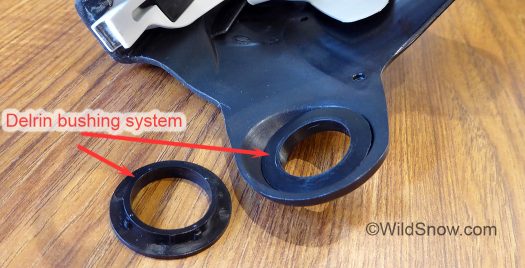
Cuff does not have removable bushings or a cant system, but it _does_ have a nicely executed Delrin bushing system that will probably last for the overall life of the boot.
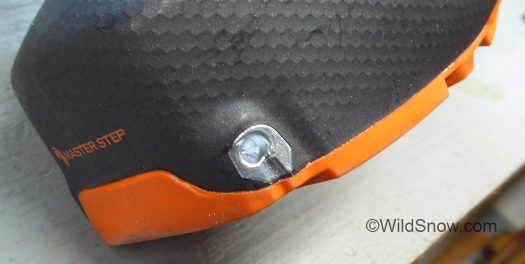
Toe fittings are the latest from Dynafit, Master Step.
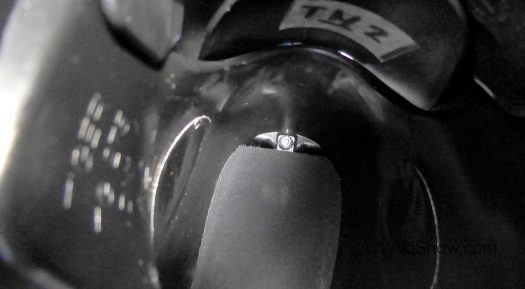
Looking into heel area of shell, Master Step fastener is visible. The shell does have a boot board, but it’s glued in. We suspect judicious application of heat will free it for customization.
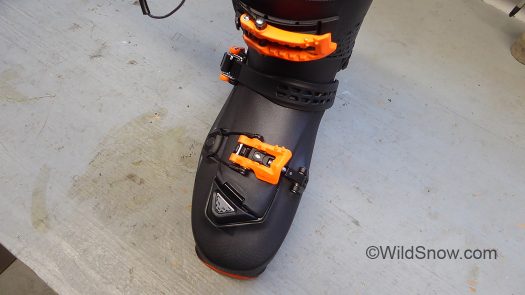
3 buckle configuration. Demonstrating amazing skills at diplomacy, Fritz and Hoji somehow convinced the Dynafit boot makers to locate a buckle strap over the boot instep instead of having it squeeze down over the top of your navicular bone like a carefully designed medieval “truth” device.
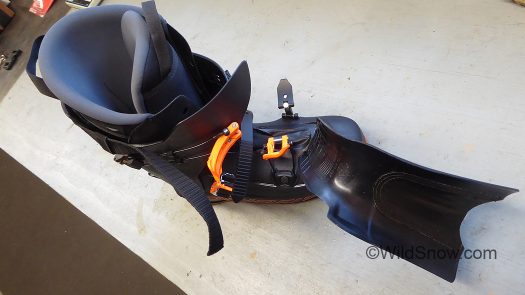
Opened up. Tongue hinges out to the side. I’m mystified as to what practical purpose this serves. Fritz and Hoji were equally baffled, explain the angled hinge is just something thrown in by Dynafit’s boot designers, probably because it looks cool. After some thought, I figured out a purpose. If you need to walk around with your boots unbuckled and the tongues folded out, they won’t snag carpet and put you on your head.
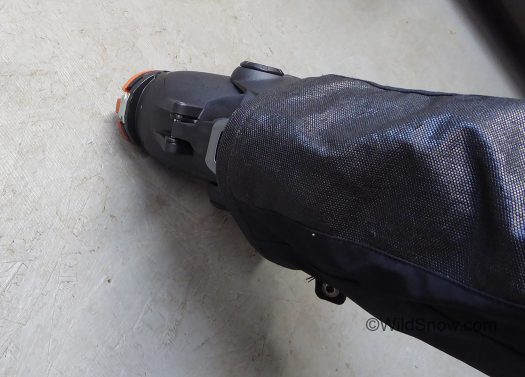
My pants dropped over the lean lock. This might have been a design violation, but they’re down, always.
A few more factoids: PX models are made from Pebax plastic, while the Pro models are Grilamid. We’ve been delighted over the years by the “punchability” of Grilamid, good to see that continue. As with other Speed Nose boots, you can use an adapter from Dynafit to mount clip-on crampons that normally need a toe shelf. Cuff rotation is said to be “55 degrees,” in practical terms I can tell you the touring articulation is adequate and possibly excellent — depends on the final retail liner — so we’ll withhold our exalted judgment on that one. Last width is said to be 103.5, I’m not sure when the industry began specifying last widths to the 1/2 millimeter…let’s just call it 103 and remember that with a well made liner and some boot fitting, last width is only one of dozens of factors that help a boot fit your foot.
Weight:
Our sample is shell size 27.5, BSL 300, 1528 grams (53.9 oz) with liner, 1232 grams without liner. I’d call this an average or slightly below average weight boot for what it is, or to be more complimentary, excellent weight considering the complexity of the lean lock system as well as the stiff flex. For sake of comparison, a much simpler boot in another brand comes in with shell weight of 1476, 52 grams less.
Conclusion:
Clearly, if the Hoji boots deliver as intended they’ll be incredibly desirable. Some of you will be on the Hoji side of the equation, asking for a boot that tours — and goes downhill good. Others will be on the Fritz side of the project, you’ll enjoy leaving your pants down, always, while simply flipping a lever to transition between climbs and descents. In both cases, brilliant. My take after skiing in the proto and working this review? Stiff flex, and my pants were always down.
WildSnow.com publisher emeritus and founder Lou (Louis Dawson) has a 50+ years career in climbing, backcountry skiing and ski mountaineering. He was the first person in history to ski down all 54 Colorado 14,000-foot peaks, has authored numerous books about about backcountry skiing, and has skied from the summit of Denali in Alaska, North America’s highest mountain.


